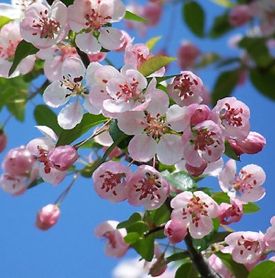Crab Apples

If you’re fond of jam and preserve-making, then you should consider having a crab apple tree (Malus). Crab apples are much too sour to be eaten, even when cooked, but they are great for making a lovely sweet orangey-pink jelly, and can also make a beautiful cordial. They also contain lots of pectin, so can be used to set other jams such as strawberry.
As a side benefit, crab apples usually carry lots of blossom, which makes them extremely pretty in spring, and also very attractive to insects. As a result, they have been used for centuries as pollinators around apple orchards.
Choosing and siting your crab apple
There are a wide range of suitable and recommended cultivars, including Malus x zumi ‘Golden Hornet’, which has large crops of yellow fruit and Malus ‘Evereste’, which has red-orange fruit.
Crab apple trees are not very fussy trees. They do best in full sun, but will tolerate partial shade, and any reasonably fertile topsoil. They don’t need a lot of pruning, so all you need to do is look out for and remove any crossing branches.
Preserving crab apples
Crab apple jelly can be eaten either with hot or cold meat, as a relish, or used as jam. This recipe is based on one from Mrs Beeton, which gives you a rough idea how long people have been making it!
Cut the crab apples in half, and simmer in water until tender (use about 1 pint water to every 1lb crab apples). Drain them through a sieve lined with muslin, or a jelly bag. Measure the strained liquid, and return it to the pan together with 1lb sugar to every pint of strained liquid. Heat gently until the sugar has dissolved, then boil hard until a set is obtained (test every 5 minutes or so). Immediately put into small jars and close.
Two years ago, faced with a glut of crab apples, I did a little experimenting, and discovered that they also make a delicious cordial. Follow the method for crab apple jelly, and after straining, return the juice to the pan. Add half a pound of sugar to every pint of strained liquid, dissolve and simmer gently for about five minutes. Taste to check the sugar levels and add more if the cordial seems too sour, again dissolving and simmering, until the cordial is sweet enough for your taste. If you’re unsure what ‘sweet enough’ is, taste a little bought blackcurrant cordial, and match that. Bottle in sterilised bottles, and dilute to taste. I’m not sure how long this cordial will keep if necessary, as it was drunk within two days in our house! But I’m guessing that it should keep at least a month, and perhaps longer in the fridge.
